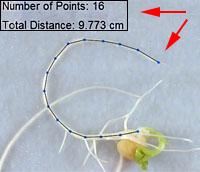A classic seed experiment
Seed germination activities are a long-time favorite of educators. One of the classic seed experiments uses a resealable plastic bag, a paper towel or napkin, seeds and water. This is a low-cost, effective tool for teaching about seeds, germination, gravitropism and energy. It also provides a perfect environment for introducing the fundamentals of the scientific method.
A twist on an old favorite
Dr. Biology’s Virtual Pocket Seed Experiment adds a twist to this classic experiment that fits into today's technology. It allows educators to introduce students to all the concepts of the original with some added features and benefits.
- The virtual version is a collection of real data that students can use to chart the results of different seed treatments.
- Each treatment is also animated so 10 days can be viewed in a matter of seconds.
- A companion Excel spreadsheet introduces students to 21st century skills as well as graphing and charting.
Virtual Pocket Seed Experiment
The best part of the Virtual Pocket Seed Experiment is it is flexible. It allows teachers to introduce as much of the virtual data as desired.
In some cases it can serve as a backup for the real-world experiment. It can be used in its fully virtual form to compress the time it takes to run the hands-on version.
The animations and companion story also serve as introductory materials to capture student imagination and interest. The virtual version is based on a real world experiment adding to its authenticity. Students can then run their own experiments and compare their results to the virtual version.
How to use the Virtual Pocket Seed Experiment
The Experiment Packet PDF contains all the educator needs for either the hands-on or virtual experiment. It also provides detailed instructions including illustrations, a sample lesson plan, handouts and materials for students to use for either experiment. It is worth downloading the reviewing the packet. There are several ways to introduce the experiment to students depending on the needs of the educator. Below are some suggestions based on instructor feedback.
- Many teachers introduce students to seeds, their anatomy and seed germination using the companion, Time Traveling Plants, story.
- Before using the virtual experiment it is best to review Experiment Overview and Data Card Help sections.
- Depending on the grade level and the time available, students can conduct the hands-on experiment or use the virtual version.
- Younger learners run the experiment and carry out the analysis.
- Older learners begin to use the companion Excel file.
- For some high school teachers the experiment is used as a quick 30-50 minute refresher for students to get them thinking critically and using the scientific method.
Arizona Science Standards
Strand One: Inquiry process
Concept 1: Observations, Questions, and Hypotheses
- PO 1. (5) Formulate a relevant question through observations that can be tested by an investigation.
- PO 1. (7) Formulate questions based on observations that lead to the development of a hypothesis.
- PO 2. (2) Predict the results of an investigation.
Concept 2: Scientific Testing (Investigating and Modeling)
- PO 1. (7) Demonstrate safe behavior and appropriate procedures in all science inquiry.
- PO 2. (4) Plan a simple investigation that identifies the variables to be controlled.
- PO 3. (4) Conduct controlled investigations in life, physical, and Earth and space sciences.
- PO 4. (5) Measure using appropriate tools (e.g., ruler, scale, balance) and units of measure.
- PO 5. (5) Record data in an organized and appropriate format.
Concept 3: Analysis and Conclusions
- PO 1. (7) Analyze data obtained in a scientific investigation to identify trends.
- PO 2. (7) Form a logical argument about a correlation between variables or sequence of events.
- PO 3. (6) Evaluate the observations and data reported by others.
Strand 4: Life Science
Concept 1: Structure and Function in Living Systems
- PO 1. (3) Describe the function of the following plant structures: roots, stems, leaves, flowers.
Concept 2: Life Cycles
- PO 2. (3) Explain how growth, death, and decay are part of the plant life cycle.
Concept 3: Organisms and Environments
- PO 5. (3) Describe how environmental factors in the ecosystem may affect a member organism's ability to grow, reproduce, and thrive.
View Citation

On screen measuring tool speeds up data collection from any zoom view.
Be Part of
Ask A Biologist
By volunteering, or simply sending us feedback on the site. Scientists, teachers, writers, illustrators, and translators are all important to the program. If you are interested in helping with the website we have a Volunteers page to get the process started.







